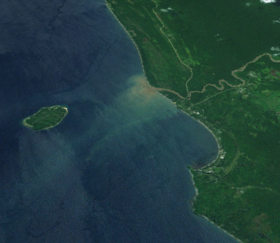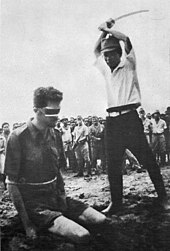Aitape
|
Aitape Eitapé (former name) |
||

|
||
| State : |
|
|
| Province : |
|
|
| Coordinates : | 3 ° 5 ' S , 142 ° 13' E | |
| Residents : | 6,931 (2013) | |
| Time zone : | AEST (UTC + 10) | |
|
|
||
Aitape (formerly Eitapé ) is a small coastal town on the north coast of Papua New Guinea in the province of Sandaun . The settlement is about 160 kilometers between the provincial capitals Wewak (east) and Vanimo (west) and thus marks the center of the road connection between these two cities. Aitape is the main town of the Aitape-Lumi district and has a 240V power supply that is usually operated 24 hours, a telephone connection, a bank, a post office, a courthouse and a police station, a supermarket and many shops, one Gas station, two airstrips, two secondary schools, a mission office, and a hospital.
Aitape was founded in 1905 by German colonists as part of German New Guinea as a mission station. The name at the time was Eitapé . During the Second World War , the city was occupied by the Imperial Japanese Army .
traffic
Aitape can be reached by roads from Vanimo and Wewak (approx. 180 km). There are also boat connections to both cities.
There are two smaller airports near the city: Tadji (IATA airport code TAJ), which is where most flights land, about 10 km east of the city, and Aitape (IATA airport code ATP).
history
Colonial times
Presumably there was already contact between the inhabitants of the Aitape area and the outside world in the 15th century, when Chinese sailing expeditions were taking place in the area. Íñigo Ortiz de Retes , the Spanish navigator and namesake of New Guinea, was probably the first European to have penetrated there. It is certain that from the early 17th century Malay fishing fleets were active along the Sepik coast, and islanders were recruited as seafarers for these Malay fishing vessels. In 1896 the first Christian missionaries came to the region with the Steyler missionaries . The first mission station was set up on Tumleo Island in 1896 . In the following year a second station followed on the mainland. The main indigenous settlements on the mainland at that time were Sissano, Malol and Arop ( inhabited by the Siau group ), as well as on the islands the settlements of Tumleo, Ali and Seleo ( inhabited by the Bakla group ). Both tribes made annual trains that led the Aitape coast to the southeastern region around Wewak in order to conduct trade there.
From 1885 the region was then part of the Kaiser-Wilhelms-Land and part of the German New Guinea colony. In order to be able to colonize the Siau and the Bakla, the Eitapé station was set up around 1905 at what is now the city, and the 3.5 kilometer wide bay there was made usable as a natural harbor ( called Berlinhafen ). As a result, the port was called regularly every ten weeks by the Reichspostdampfer Manila on the New Guinea-Singapore Line ( North German Lloyd ). The St. Anna mission station was adjacent and the settlement received a solid prison and a powerful radio transmitter that enabled communication with Europe. Organizationally, the settlement belonged to the Friedrich-Wilhelmshafen district . The main product of the area was copra , which was carried away by Manila .
In 1908 the coast of Aitape was hit by a large tsunami , which wreaked havoc in the coastal area between Arop and Sissano and formed the lagoon of Sissano, about 30 km west of Aitape. A second tsunami occurred in 1935, the most recent one occurred in 1998 and also struck Sissano.
After the First World War , the city, along with the rest of German New Guinea, was administered as a mandate of the League of Nations of Australia . Since 1975 they have been part of the independent state of Papua New Guinea.
Second World War
During the Second World War, the city, along with the rest of New Guinea's territory, was initially occupied by the Imperial Japanese Army. The Japanese also laid out the Tadji airfield .
The Australian secret service soldier Leonard Siffleet was beheaded by Japanese on October 24, 1943 on the beach in Aitape.
To recapture New Guinea, American forces carried out a tripartite landing operation on the island in 1944 to eliminate the Japanese 18th Army in Wewak and Hollandia . One of these ventures was aimed at Aitape on April 22, 1944, in order to capture the Tadji airfield and deny the Japanese the possibility of an attack from Wewak along the coast. A large base was set up in Aitape for this purpose. Another attack in the direction of Wewak was finally refrained from as the Japanese troops stationed there posed no threat due to illness and lack of supplies. In mid-1944, Australian forces took over the base from the Americans.
They used the site as a base for their Aitape Wewak campaign , the last campaign of the Australian Imperial Force in New Guinea from November 1944 to August 1945.
diocese
Since 1952 the city has been the seat of the Roman Catholic diocese of the Aitape diocese ( Latin : Dioecesis Aitapensis ).
1998 earthquake and tsunami
In July 1998, the area around the city suffered a devastating earthquake followed by a tsunami that killed over 2,000 people. The 7.0 magnitude earthquake hit the coast and triggered a large underwater landslide that started the tsunami. The hardest hit area was the village of Warapu, about 8 km west of Aitape. The village lay on a narrow strip of land between the coast and a large lagoon. It is estimated that waves an average height of 10.5 meters went over the spit into the lagoon.
literature
- Keyword: Eitapé. In: Heinrich Schnee (Ed.): German Colonial Lexicon. Quelle & Meyer, Leipzig 1920, Volume I, p. 553 ( online ).
Individual evidence
- ↑ Keyword: Berlinhafen. In: Heinrich Schnee (Ed.): German Colonial Lexicon. Quelle & Meyer, Leipzig 1920, Volume I, p. 184 ( online ).
Web links
- Homepage of the Diocese of Aitape - Diocese of Aitape - ( http://www.global.net.pg/diocese_of_aitape/aitape/gen.html online)


